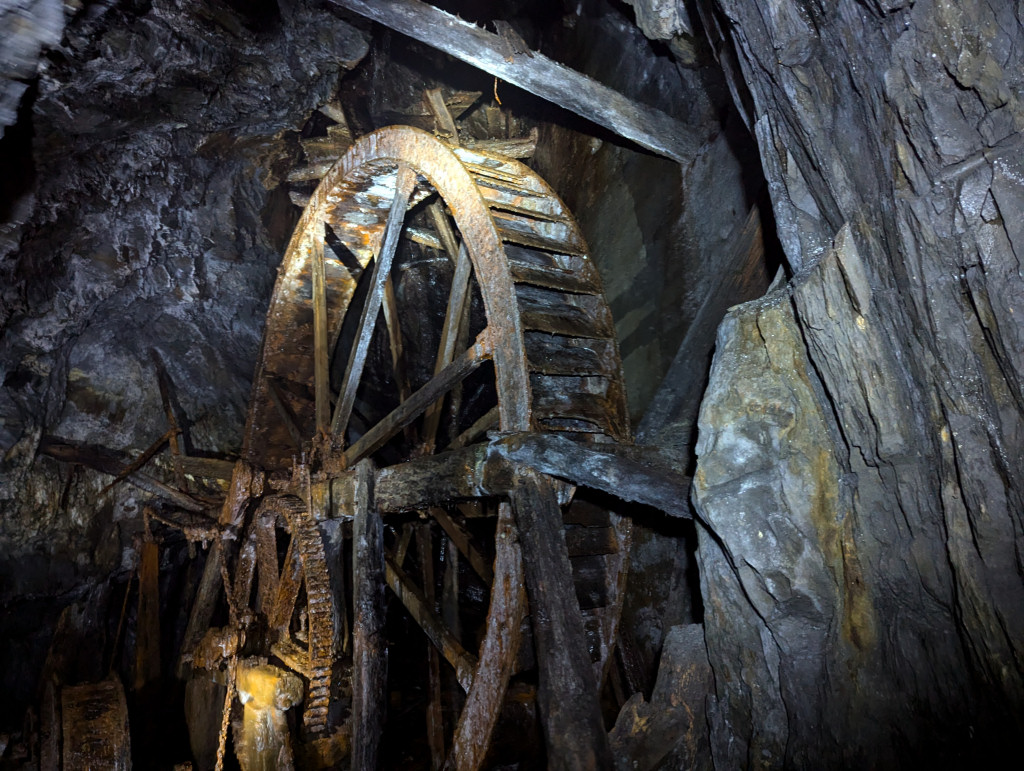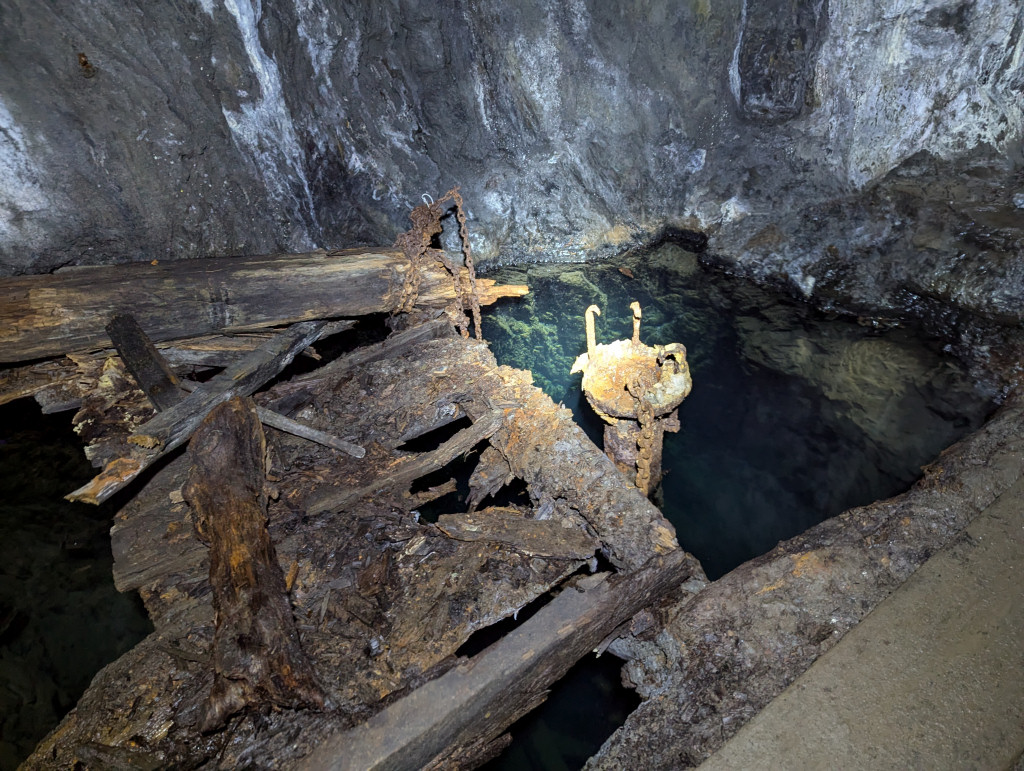At top of site is 460’ deep Engine Shaft. Below this, extending some distance downhill are some buildings that housed crushers and water wheels. The remains of an overgrown buddle pit (there are two) lies in front of the buildings. The deep adit is further down the hill.
The adit leads immediately to an intersection (with two lodes?) and a stope or shaft above. This area houses the underground water wheel and associated pumping equipment. A pump pipe can be seen descending for some distance in the flooded shaft/winze.
Right hand branch follows a 1“ rib of galena for some distance before ending.
Leftwards passes a couple of side workings to another flooded winze or stope that can be crossed using a wooden plank. This leads after some distance to two partially filled passages at the base of the New Engine Shaft (as seen on surface). Subrit reference says:
At the base of the shaft there is a 10 foot climb up to a higher level where a large rusty kibble stands at a crossroads. The level is blocked left and right after a short distance but straight ahead it continues several hundred yards to a collapse. However extreme caution is required here as there is a flooded and partially boarded shaft in the floor which cannot be seen as there are several inches of water over the floor at this point.
There are 4 levels of workings linked by shafts. Only deep adit level explored in making description above.
There are 4 adits in total, but the Subbrit reference mentions ‘the only other accessible adit’ as being…
70 yards north of the crusher house at the top of a substantial spoil tip; there is a little water in the entrance. After a short distance the level turns to the right into a small stope. It is possible to climb down into the stope but further progress is blocked by falls.
| Year | Activity |
|---|---|
| 1871 | Lancastrian entrepreneur, Mr Adam Mason (who spent £3,000 on the mine) sank winze to 12 fathom level. Water wheel installed enabling winze to sink another 12 fathoms |
| 1870s | Engine Shaft sunk to 30 fathoms. 1 1/2 mile leat built. Two water wheels built - one for pumping and drawing, the other for crushing. Another waterwheel to drive 2 buddles |
| 1877 | Mason and Richards throw dinner for workers, agents etc. to celebrate plant installation |
| 1891 | Ore finally returned, but under new management. 9 miners underground, 2 lads on surface |
| 1891-1897 | 9 tons of lead ore and 45 tons of copper ore recorded. 20 tons of the copper ore assaying at 22% copper |
| 1903 | Mine closed, most of machinery sold or scrapped |
Parking place near road where forest track forks in two, not far from the road.
Waterwheel (NPRN 415676)
External Links
Publications (33)
- (1922); BGS - Mineral Resources of GB (c1920s) Vol XX - Lead and Zinc: Cardiganshire & West Montogmeryshire; 242 pages
- (1982); CATMHS - Newsletter 001; 27 pages
- (1982); WMS Newsletter Issue 07 Dec; 3 pages
- (1983); WMS Newsletter Issue 09 Dec; 3 pages
- (1984); WMS Newsletter Issue 10 Jun; 3 pages
- (1985); CATMHS - Newsletter 011; 23 pages
- (1986); CATMHS - Newsletter 013; 18 pages
- (1988); WMS Newsletter Issue 18 May; 12 pages
- (1988); WMS Newsletter Issue 19 Dec; 6 pages
- (1989); WMS Newsletter Issue 20 Jun; 4 pages
- (1990); WMS Newsletter Issue 23 Dec; 8 pages
- (1993); WMS Newsletter Issue 29 Dec; 8 pages
- (1994); WMS Newsletter Issue 31 Dec; 10 pages
- (1996); CATMHS - Newsletter 047-August; 30 pages
- (1996); WMS Newsletter Issue 34 Jun; 7 pages
- (1997); WMS Newsletter Issue 37 Dec; 11 pages
- (2000); WMS Newsletter Issue 43 Oct; 16 pages
- (2001); WMS Newsletter Issue 45 Dec; 14 pages
- (2017); CATMHS - Newsletter 126-February; 38 pages
- (2019); CATMHS - Newsletter 136-August; 40 pages
- Bick, D.E. (1991); Old Metal Mines of Mid-Wales, The; North of Goginan - Part 3; pp. 43
- Foster-Smith, J.R.; NMRS (1979); British Mining 12 - Mines of Cardiganshire, The; ISBN 0 901450 14 6; pp.18,73.
- Hughes, Simon J. (1980); Ystrad Einion Wheel; 1 pages
- Hughes, Simon J.; Ystrad Einion Plan; 1 pages
- Hughes, Simon J.S. (1989); UK Journal of Mines & Minerals No 6, Spring - History of Ystrad Einion Mine, The; 8 pages
- Hughes, Simon J.S. (1991); British Mining Volume 43 - Castell & Nant y Creiau Mines, The; 23 pages
- Jones, Nigel and Walters, Mark and Frost, Pat (2004); Mountains and Orefields; 208 pages
- NMRS; British Mining 43 - Memoirs 1991; pp.102.
- NMRS; British Mining 93 - Memoirs 2012; pp.76.
- NMRS; Newsletter Aug/1991; pp.9.
- NMRS; Newsletter Feb/1988; pp.7.
- NMRS; Newsletter Nov/1987; pp.2.
- NMRS; Newsletter Sep/1977; pp.5.








